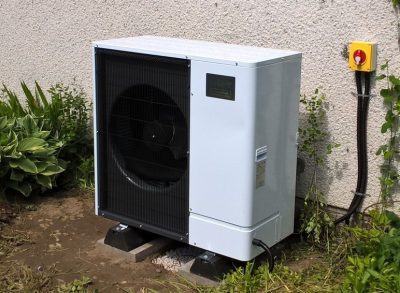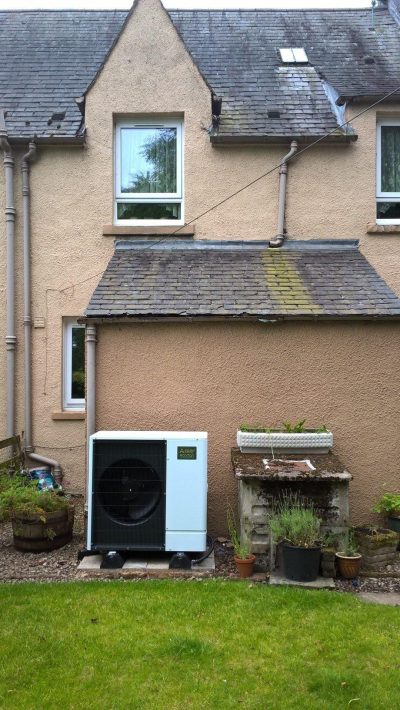Heat Pumps
Heat pumps are an environmentally friendly way of heating your home and providing hot water, though they can be expensive. They run on electricity which is essential in reducing carbon emissions. Heat pumps are most cost effective when replacing oil, electric or coal heating systems. The three main types of heat pumps are air source, ground source, and water source. Any of these could potentially replace your current central heating system. However, the most appropriate system for your home depends on the building type, its position, grounds, and other factors. Air source heat pumps absorb heat from the outside air. This heat can then be used to heat radiators, under floor heating systems, or warm air convectors and hot water in your home. It can get heat from the air even when the temperature is as low as minus 15°C. Other types of heat pump can extract heat from the ground or even from water. The heat they extract from the ground, air, or water is constantly being renewed naturally, which saves costs on fuel and reduces carbon emissions. However, they still have an environmental impact as they require electricity to run.
The air source heat pump is the most installed heat pump in the UK due to its easy installation, lower costs, financial support and benefits.

Water source heat pumps are a more niche renewable technology and require a large quantity of water to work. They work similarly to ground and air source heat pumps. Instead of using the heat in the ground or air, they use the consistent temperature in a water source.
They transport heat from a water source such as a loch, pond, stream, or river, to your household. To use a water source heat pump your home must be near a water source and have enough space to lay pipes between the water source and your building. The pipework is submerged in the water source and so will have a minimal impact visually and on your land space. It also requires a system compressor which will be located inside your building.
Energy used for cooling, heating, or hot water is pumped from the water directly and can save you a significant amount of energy annually. Water source heat pumps deliver their best results when the water temperature is between 5 and 8 degrees Celsius. In cold weather conditions, its net performance could drop during the winter.
For more information, visit the Energy Saving Trust.
Below is a short video produced by Energy Saving Trust explaining ground source heat pumps
Below is a short video produced by Energy Saving Trust explaining air source heat pumps
The cost of an air source heat pump varies differing on the brand, model and size of heat pump, the size of the property, type of property, as well as whether you need to change the way you distribute heat around your property. It is recommended that you speak to at least three installers to provide a quote for your heat pump system to give you the best idea of likely costs for your home.
Typical costs for air source heat pumps are around £8,000 to £14,000. Ground source heat pumps are more expensive, costing between £18,000 to £30,000 due to the installation of pipes underground. In comparison, buying and installing a new boiler would cost around £2000 to £5000.
The Home Energy Scotland Loan can help with installation costs. With heat pumps, you could receive up to £10,000 in funding. Up to 75% could be cashback (£7,500), and you would pay back the remaining £2,500 as an interest-free loan.
Heat pumps can be installed in most homes, though there are some considerations that must be addressed first. You should check if planning permission is required by referring to the Perth & Kinross Council planning permission page.
For a heat pump to work at its most efficient, your home needs to be well insulated. A poorly insulated house would require a larger heat pump to compensate for the heat loss, and this could cost more money to install and to run. Therefore, it is essential to take a fabric first approach before considering installing heat pumps, to maximise heat conservation through insulation and air tightness.
Heat pumps work more efficiently on lower temperature heating systems. Older poorly insulated houses may require higher temperatures to get the house warm and the heat pump may be unable to cope with this.
If you already have an underfloor heating system or are thinking of installing one, an air source heat pump works particularly well with these as they are most efficient when producing low water temperatures.
Pairing your radiators with a heat pump can minimise disruption in your home. However, radiators will need to be sized in line with lower water flow temperatures associated with heat pumps. Generally, this means they should be twice the size of those used with a gas or oil boiler.
Air source heat pumps are more popular in off-grid locations, as they have lower running costs than oil or electric only heating systems. If your property does not have access to a mains gas, a heat pump could be a particularly cost-effective choice. For every unit of electricity consumed by an air source heat pump, it produces three times the amount in heat energy.
However, well-insulated properties that have access to mains gas are still suitable for heat pumps. With the correct design and installation, running costs are low in comparison to mains gas.
Heat pumps and gas boilers work in two very different ways. Switching to a heat pump means you must consider where it will be installed, usually they are located outside your home. The ideal location depends on the type of heat pump, but typically it’s best located on the ground at the back of a property.
Ground source heat pumps are typically more difficult to install. With large land areas the pipes can be laid horizontally, but with small gardens the pipes need to be installed vertically in boreholes around 100 metres deep. A standard borehole is approximately 120 – 150mm in diameter and between 1-12 can be required depending on project size. They do not require airflow and can be placed in your home. However, they can be quite large so would only be suitable in a cellar or utility room.
To use a water source heat pump your home must be near a water source and have enough space to lay pipes between the water source and your building. The pipework is submerged in the water source and so will have a minimal impact visually and on your land space. It also requires a system compressor which will be located inside your building.
As an air source heat pump requires good air flow to work, it must be installed outside of your home to draw air in and allow cold air to exit once the heat has been extracted. It should be installed in an easily accessible location where you can adjust its settings, and any outside wall should be suitable as long as there is enough space for the pump to take in air. The outdoor unit should be no bigger than 0.6 cubic metres. However, you will need some space inside for the domestic hot water cylinder, buffer tank, and other components.

Most air source heat pumps are between 4-15 kW in output. The larger your home and higher demand for hot water, the higher the output. Sizing an air source heat pump can be complex and it is recommended you use an experienced professional to calculate the best size for your home.
Your installer and heat pump must be certified under the Microgeneration Certification Scheme (MCS). You can find installers in your area (as well as customer reviews) on Energy Saving Trust's Renewables Installer Finder. For a full list of MCS-certified installers, see the Microgeneration Certification Scheme website.
With heat pump installation comes extra demand for electricity on the local grid. Therefore, you are required to get permission from the District Network Operator (DNO) before making the connection. This will be done by the installer.
Heat pump efficiency is measured by the unit CoP which measures electricity inputted and heat outputted. A heat pump that has a CoP of three can create three kW of heat from every one kW of electricity.
The average home requires around 12,000 kilowatt hours (Kwh) of heat per year. To achieve this, a heat pump with a CoP of three would use 4000 kWh of electricity per year.

